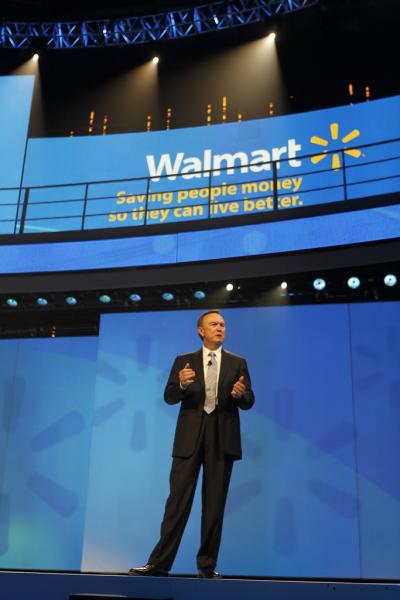Why Workers Are Protesting Conditions In Wal-Mart's Warehouses

President Lincoln’s statement urging this nation to value its labor force represents a fairly unique perspective in the context of our earlier history. The American labor legacy has included atrocities against the workers who made our economy possible, ranging from slavery to the highly unsafe working conditions of the Industrial Era. And observing the recent tragedy of the Pakistan factory fires, reminiscent of the eerily similar Triangle Shirtwaist Factory of 1911, many might remark that the U.S. now stands as a shining example of valuing safety over profit in the workplace. But we need to take a closer look at our own companies’ business practices before we make that claim.
Stores like Costco, Target, and Kmart make their killing hocking something nearly everyone wants and needs: savings. But few are as successful selling the sale as Wal-Mart, the world’s largest retailer, whose economic niche for the past 50 years has been boasting the lowest prices. In fact, as you can see in the picture of Wal-Mart President and CEO Mike Duke, the No. 1 Fortune 500 company is “saving people money so they can live better.” While the consistently low prices cost customers less of their hard-earned money, the process providing those deals bars thousands of warehouse workers from that “better” life.
According to a list of the 2011-2012 Highest hazardous Industry List in California, comprised of over 1724 establishments and 68,580 employees, warehouse work in California causes 630 percent of the industry average of work-related injuries, an issue that certainly applies to the warehouses supplying Wal-Mart goods. Workers of the Inland Empire warehouses, located in Southern California and acting as a “nerve center” for Wal-Mart good suppliers, could certainly illustrate the damaging effects of working the Wal-Mart way.
Pushing its supply chain to provide faster, more profitable results, the billion-dollar corporation sends a cascading wave of pressure down onto the workers’ overworked and vulnerable backs and shoulders. Imbued with Wal-Mart’s economic clout, Wal-Mart’s insistence on “inhumane quotas” at any cost results in increased levels of job-related injuries, which are financially disastrous to these workers, whose health care is minimal to non-existent and whose pay, $8 an hour and about $12,000 a year, is not sufficient to support a family even without taking into consideration medical costs and time off for recovery.
According to the National Employment Law Project, Wal-Mart has a better organized system of passing the buck than any politician. Employing domestic supply chains, Wal-Mart exploits its workers. The danger of the intolerable pace is exacerbated by crowded conditions, malfunctioning equipment, inadequate access to clean drinking water and 100+ degree temperatures.
This past Wednesday, three dozen warehouse workers in Mira Loma, CA, despite the risk of not having union protection, decided to walk off the risky job. The workers’ protest of unsafe conditions didn’t end there. About half of these workers committed to what they call a “pilgrimage,” a six-day, 50-mile march from the Jurupa Valley to Dowtown Los Angeles, which will culminate in a rally outside City Hall on Tuesday morning. This pilgrimage attempts to hold Wal-Mart accountable for the working conditions of its subcontractors.
But according to Wal-Mart’s spokesman, Dan Fogelman, the workers' complaints are not legitimate and are “[dragging] Wal-Mart’s name in the discussion to get the media to pay attention to them.” Yet, while the media attention certainly helps, the workers' ultimate goal is to get Wal-Mart’s attention. These workers, despite being given the run-around after every complaint, know that Wal-Mart has the power to change their daily working conditions.
And it’s not only in Southern California where Wal-Mart’s ethics are in question. A day after the Inland Empire warehouse workers went on strike, Warehouse Workers for Justice in Chicago filed a suit, the eleventh in the past three years, against warehousing chains employed by Wal-Mart that have withheld and incorrectly documented workers’ overtime pay.
And, despite Wal-Mart CEO Duke’s claims of a “commitment to transparency and holding ourselves accountable for what we do within our company and for our communities,” Wal-Mart still uses its degrees of separation from warehouse workers, like those in Southern California and Chicago, to ignore the thousands of dollars worth of citations its chosen supply-chains accrue each year.
Should Wal-Mart be held accountable for warehouse working conditions?
In an email encouraging more than the already 25,000 supporters to lend their support to the Inland Empire workers' protest, worker Limber Herrera said, “Because we work for subcontractors, Wal-Mart thinks it can look the other way and pretend it has nothing to do with the illegal working conditions we face. Not anymore.”
Read more of Neon Tommy's coverage on Wal-Mart here.
Reach Contributor Zion Samuel here.



